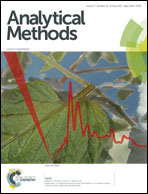Screening of antioxidant, antimicrobial and antiradical activities of twelve selected Serbian wild mushrooms
Abstract
This study was undertaken to evaluate and compare the antioxidant, antimicrobial and antiradical activities of twelve wild edible mushrooms from Serbia. The antioxidant activity was evaluated by five different methods: DPPH, ABTS, total reducing power (TRP), ferric reducing antioxidant power (FRAP), and cupric reducing antioxidant capacity (CUPRAC). Folin–Ciocalteu total phenolic compounds (TPC) were also determined. The present study shows that the ethanol extract of Boletus regius has the highest antioxidant values (10.997 ± 0.891 mg mL−1 in DPPH; 0.771 ± 0.004 mg AAE per mg dw in TRP; 56.924 ± 0.022 mmol Fe per mg dw in FRAP; 21.738 ± 0.108 mg TE per mg dw in CUPRAC; 173.125 ± 0.475 mg GAE per mg dw in TPC). This is the first report on the evaluation of the antioxidant activity of ethanol extracts of mushrooms by the CUPRAC method. The in vitro antimicrobial activity was investigated by the microdilution method. This is the first report on the antimicrobial activity for many analyzed mushroom species. The highest antiradical activity unit (EAU515) was from Polyporus squamosus (6.349 EAU515). We determined the antioxidant capacity and the antioxidant potency composite index (ACI) was calculated. Agglomerative hierarchical clustering (AHC) was applied to investigate the similarities between the used methods for antioxidant activities. PCA was used for determining the number of variables to explain the observed variances in the antioxidant activity data of the examined wild mushroom species.


 Please wait while we load your content...
Please wait while we load your content...